HE-400S
back to HIFIMAN
back to measurements
home
Published: Jul-18-2017
NO SMOOTHING is applied to the shown plots. Most measurement sites have some smoothing applied which ‘irons flat’ sharp peaks and ‘wiggles’. I do not use smoothing because some info about sound quality is lost when plots are smoothed.
Aside from a small correction of the microphone itself also some correction in the lowest frequencies is applied to the plots to compensate for the perceived loss of bass when using headphones. This is described HERE in more detail.
A ‘horizontal‘ frequency response curve on the shown frequency response plots on this website thus indicates a perceived ‘flat’ tonal signature.
ALL measurements are made with a good SEAL on a flatbed measurement rig.
The shape of your head, bone structure, pad size, pad ‘softness, (compliance), hair or no hair and or wearing glasses may (drastically) change the frequency response of some headphones, so… your personal experience may differ substantially from these plots.
Frequency response (tonal balance) is the most sound-determining aspect of headphones. A horizontal line shows audible neutral response in the plots on this website. Deviations in different severities at different frequency bands have an effect on the sound character.
The bigger the deviation the stronger the effect.
Below an aid to help determining the sound character of headphones with relation to the frequency response.

HIFIMAN HE 400S

The HIFIMAN HE 400S is an entry level planar magnetic over-ear headphone. It retails for around € 400.- which is not very expensive for a planar magnetic headphone.
Its low impedance makes it suited to drive it directly from portable equipment.
Its size and open character make it less suitable for commuting.
Comfort is excellent, the clamping force is somewhat on the high side but because of the large pads the pressure is well distributed and ensures a good seal.
The weight of this planar headphone is low compared to ‘similar’ headphone types. This is largely due to the way the drivers are built.
The headphone cable is short and can be replaced.
specifications:
Type: Over ear, open
Usage: Home, portable
Driver type: planar magnetic
Pads: replaceable, velours
Fold-able: No, but can rotate the cups in a flat position.
Headphone connector: 2,5mm TRS (marked L and R)
Cable entry: double sided
Cable: replaceable 1.5m with gold plated 3.5 mm TRS plug and 6.3 mm adapter
Driver size: 60 mm
Nom. power rating: 6 W
Max. S.P.L. 131 dB (12Vrms)
Impedance: 22 Ω
Efficiency: 94 dB @ 1mW
Sensitivity: 106dB @ 1V
Weight: 350 g.
Clamping force: medium/high
Accessories: 6.3mm adapter
measurements:
Below the frequency response of the HE 400S (Left, Right)
The channel balance is good above 200Hz. The tonal balance is just slightly on the warm side. It is lacking in real deep bass and bass extension. Bass sounds clean but lean.
The 5dB dip at 2kHz lowers some sense of the ‘clarity’ and ‘edge/attack’ of certain instruments.
The 8kHz peak is very narrow (pointing to a resonance) and peaks about 7dB above the mids.
Because it is very narrow and up high it doesn’t manifest itself as sibilant BUT it sometimes (when overtones are present in that narrow band) it gives the sound an unnatural ‘edge’ that, when removed’ will make the treble perfectly smooth and pleasant.
For about € 100.- more you can buy the HE 400i.
Below the differences between the HE 400S and HE 400i are shown.
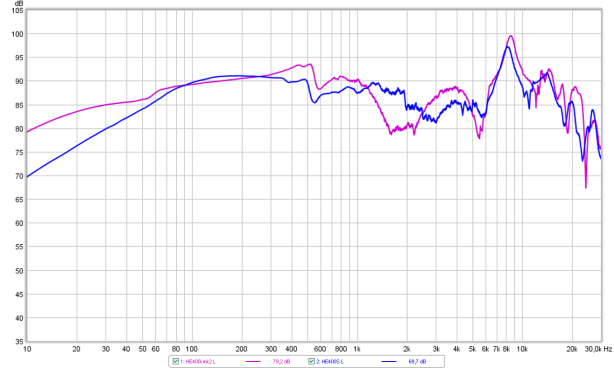
Aside from the amount of bass the HE 400S is more neutral but has the same treble peak and treble response. The HE 400S is a little more laid-back and warmer.
The tonal balance differences are shown more clearly in the 1/3 octave smoothed plot below. HE 400S and HE 400i

Below the distortion measurements of the HE 400S (Right channel).
Note that this headphone was measured at ![]() where background noises were present in the demo room. As this is an open headphone the distortion levels and spectrum plot performance may thus be better in reality than as shown on the plots due to ambient sounds being measured along with the headphone.
where background noises were present in the demo room. As this is an open headphone the distortion levels and spectrum plot performance may thus be better in reality than as shown on the plots due to ambient sounds being measured along with the headphone.
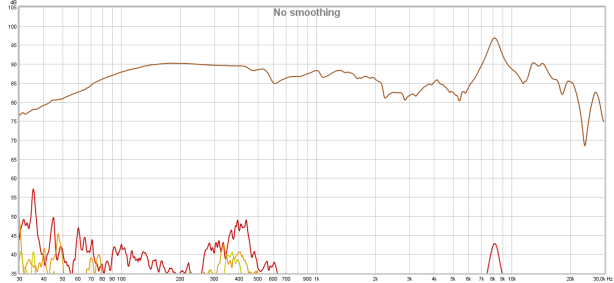 Around 400Hz the peaks are caused by ambient noises during the measurements.
Around 400Hz the peaks are caused by ambient noises during the measurements.
Above 500Hz the distortion levels look good, the peak at 8kHz barely touches the 0.2%
Don’t take these plots for reality. The distortion levels will (most likely) be much better when they were measured in a quiet room. The rise in distortion below 100Hz may be (partly) caused by ambient sounds but as Tyll’s plots also show a similar rise the distortion may well be in that area. Do note that distortion in these low frequencies is not heard as ‘distortion’.
Below the distortion plot but displayed in percentages.
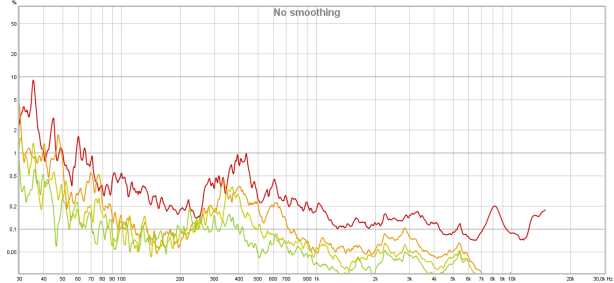
Below the CSD of the HE 400S. (Left and Right are superimposed)
At 5kHz and 12kHz there is some ringing. The ‘mess’ between 500Hz and 3kHz is probably ambient sounds.
output resistance / damping-factor
As this is a planar magnetic headphone its impedance is as good as ruler flat so a higher output resistance amplifier will have no consequences for the frequency response/tonal balance/damping.
Below the spectrum plot of the HE 400S. 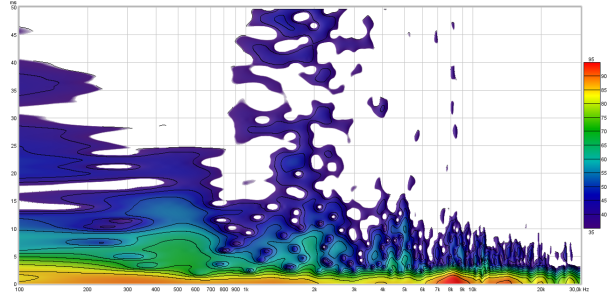
The spurious signals in the upper middle part of the plot are ambient sounds and not from the headphone itself. At 8kHz the peak is visible.
The step response (Right channel) below shows the bass is quite rolled-off. There is quite some overshoot and some resonances. Far from exemplary behavior.
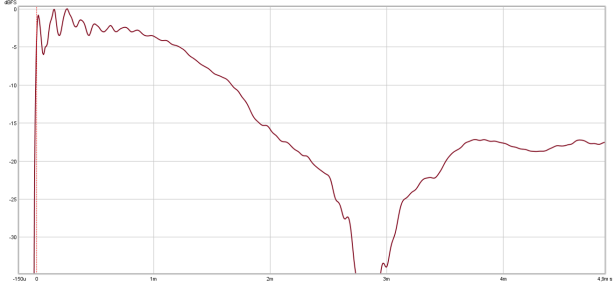
The left channel shows a similar pattern and thus not shown.
summary
Fit and finish, comfort, weight (for a planar) are nice. The aluminium color scheme is a bit basic. The sound signature is ‘lean’ but the mids are O.K. but perhaps lacking in clarity somewhat. Treble is present and not splashy nor sibilant.
The 8kHz peak gives some recordings a ‘sharp-ish’ edge to them. Some people may be bothered by it, others may not. Something you may have to find out for yourself.
The slight ‘ringing’ at 8kHz is something that could be addressed with a very sharp notch EQ. The lower bass could be more present but you can turn up the bass with your tone control.
